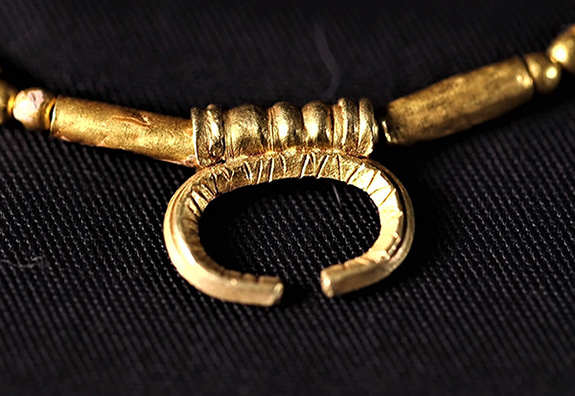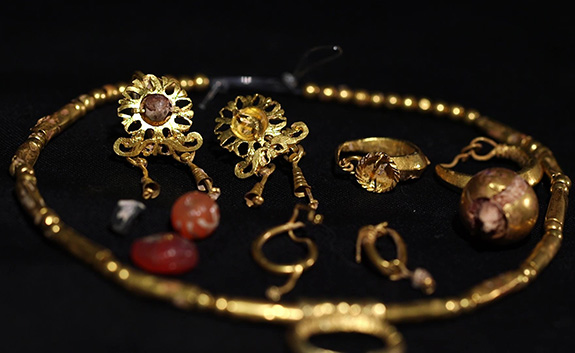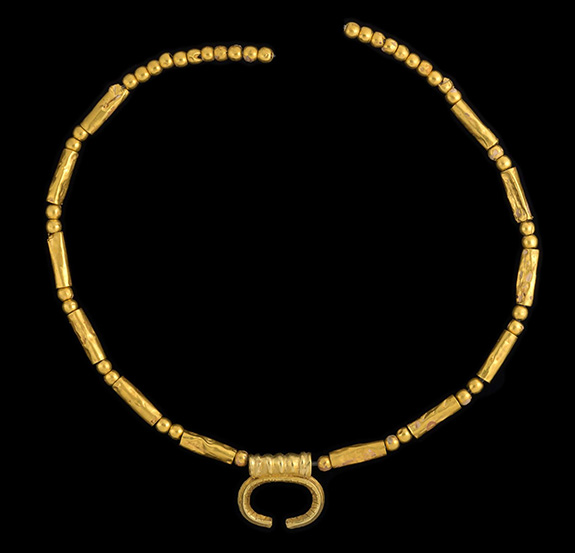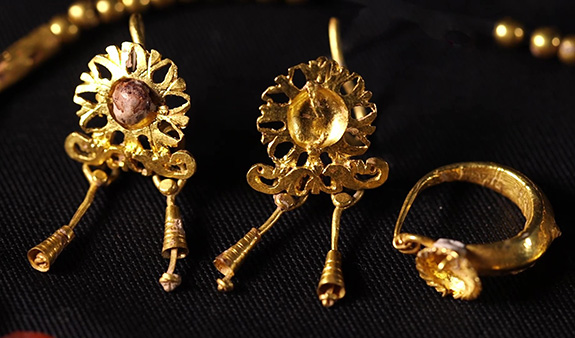April 20th, 2023
A cache of impressive gold jewelry worn by a Roman girl more than 1,800 years ago to ward off evil spirits — and buried with her to provide protection in the afterlife — was recently unveiled by the Israel Antiquities Authority (IAA).

A gold "lunula" pendant, along with gold earrings, gold hairpin, and beads made of gold, carnelian stone and glass were discovered in a lead coffin by Yael Adler in 1971, but the archaeologist sadly passed away before she could publish her findings.
The gold jewelry and her perfunctory archaeological report ended up in storage at the IAA and were forgotten for more than 50 years.

Earlier this month, the beautiful jewels and their backstory were finally presented at the 48th Archaeological Congress organized by the Israel Antiquities Authority, the Israel Exploration Society and the Israel Archaeological Association.
The IAA's effort to revisit old discoveries is part of an initiative called “Publication of Past Excavations Project,” whereby old excavations that had not been fully published are now getting their time in the limelight.
“The location of the original reports that gathered dust over the years in the Israel Antiquities Authority archives, and physically tracing the whereabouts of the items themselves, has shed light on long-forgotten treasures,” said Dr. Ayelet Dayan, the head of IAA's archaeological research department. “The beautiful jewelry that we researched is an example of such treasures.”

The gold lunula pendant (shaped like the crescent moon and named after the Roman moon goddess Luna) was of particular interest to the IAA team. The archaeologists believe it was worn as an amulet by a young woman during the Late Roman period (about 130 AD).
According to IAA researchers Dr. Ayelet Dayan, Ayelet Gruber and Dr. Yuval Baruch, the very valuable gold item bearing the symbol of the goddess, was likely worn by the girl during her lifetime. And then after her death, she was buried with the pendant so it could protect her in the afterlife.

The archaeologists believe the girl lived during the Late Roman era, about 60 years after the destruction of the Jerusalem Temple in 70AD.
According to the IAA, people from different parts of the Roman Empire settled in the city of Jerusalem, bringing with them a different set of values, beliefs and rituals.
“The interring of the jewelry together with the young girl is touching," noted Eli Escusido, director of the Israel Antiquities Authority. "One can imagine that the parents or relatives parted from the girl, either adorned [her] with the jewelry, or possibly [laid it] by her side, thinking of the protection that the jewelry provided in the world to come. This is a very human situation, and all can identify with the need to protect one’s offspring, whatever the culture or the period.”
Credits: Photos by Emil Aladjem, Israel Antiquities Authority.

A gold "lunula" pendant, along with gold earrings, gold hairpin, and beads made of gold, carnelian stone and glass were discovered in a lead coffin by Yael Adler in 1971, but the archaeologist sadly passed away before she could publish her findings.
The gold jewelry and her perfunctory archaeological report ended up in storage at the IAA and were forgotten for more than 50 years.

Earlier this month, the beautiful jewels and their backstory were finally presented at the 48th Archaeological Congress organized by the Israel Antiquities Authority, the Israel Exploration Society and the Israel Archaeological Association.
The IAA's effort to revisit old discoveries is part of an initiative called “Publication of Past Excavations Project,” whereby old excavations that had not been fully published are now getting their time in the limelight.
“The location of the original reports that gathered dust over the years in the Israel Antiquities Authority archives, and physically tracing the whereabouts of the items themselves, has shed light on long-forgotten treasures,” said Dr. Ayelet Dayan, the head of IAA's archaeological research department. “The beautiful jewelry that we researched is an example of such treasures.”

The gold lunula pendant (shaped like the crescent moon and named after the Roman moon goddess Luna) was of particular interest to the IAA team. The archaeologists believe it was worn as an amulet by a young woman during the Late Roman period (about 130 AD).
According to IAA researchers Dr. Ayelet Dayan, Ayelet Gruber and Dr. Yuval Baruch, the very valuable gold item bearing the symbol of the goddess, was likely worn by the girl during her lifetime. And then after her death, she was buried with the pendant so it could protect her in the afterlife.

The archaeologists believe the girl lived during the Late Roman era, about 60 years after the destruction of the Jerusalem Temple in 70AD.
According to the IAA, people from different parts of the Roman Empire settled in the city of Jerusalem, bringing with them a different set of values, beliefs and rituals.
“The interring of the jewelry together with the young girl is touching," noted Eli Escusido, director of the Israel Antiquities Authority. "One can imagine that the parents or relatives parted from the girl, either adorned [her] with the jewelry, or possibly [laid it] by her side, thinking of the protection that the jewelry provided in the world to come. This is a very human situation, and all can identify with the need to protect one’s offspring, whatever the culture or the period.”
Credits: Photos by Emil Aladjem, Israel Antiquities Authority.


